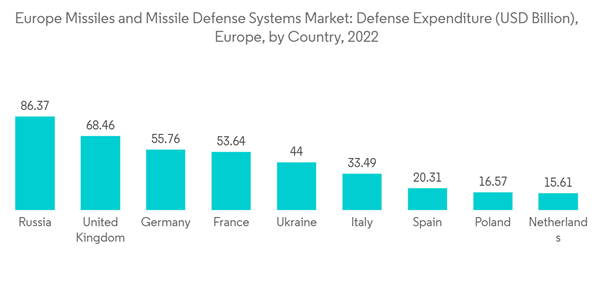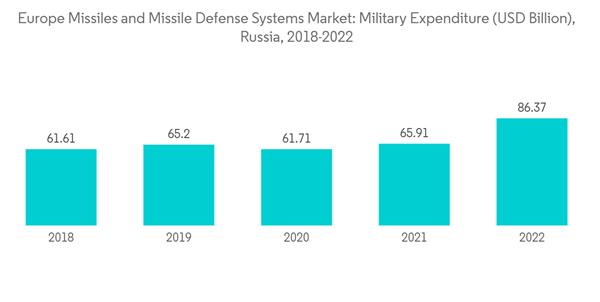The Europe Missiles And Missile Defense Systems Market size is estimated at USD 3.79 billion in 2024, and is expected to reach USD 4.83 billion by 2029, growing at a CAGR of 4.94% during the forecast period (2024-2029).
This product will be delivered within 2 business days.
Key Highlights
- The Russia-Ukraine conflict altered the European defense landscape. Thus, European Union (EU) and North Atlantic Treaty Organization (NATO) member states acted collaboratively and aggressively to defend political and defense interests. A progressive and strategic increase in the European defense budget and the launch of infantry support projects are expected to create demand for sophisticated new-generation missiles with advanced capabilities, thereby driving the market in focus during the forecast period.
- However, the supply chain disruptions have deleteriously affected the sourcing of critical components and materials for the design, development, and manufacturing of sophisticated missiles and missile defense systems. Furthermore, the market is also affected by the long R&D cycle and cost-intensive nature of the defense industry, which exposes market players to economic fluctuations.
Europe Missiles & Missile Defense Systems Market Trends
Short Range Missiles to Dominate the Market Share During the Forecast Period
- Europe's geopolitical landscape includes neighboring regions with potential security threats. Short-range missiles are well-suited for defense against immediate and nearby threats, making them strategically vital. Short-range missiles are anticipated to hold the largest market share during the forecast period. A ballistic missile with a range of 1,000 km (620 mi) or less is referred to as a short-range ballistic missile (SRBM). They are primarily used as a strategic deterrent in local conflicts due to their relatively low cost and ease of configuration.
- Due to tumultuous military scenarios in the region, such as Russia's invasion of Ukraine, cross-border conflicts, and rising terrorism, European nations have significantly increased their annual defense spending and associated military budget. For instance, in February 2022, the German government allocated an additional USD 112.7 billion to its armed forces, including provisions for investments and weaponry programs for German military forces. In addition, the French Armed Forces proposed a USD 42.9 billion military budget for 2023, marking a USD 3.0 billion increase over the previous year.
- Moreover, Europe faces a diverse range of threats, including drones, cruise missiles, and ballistic missiles. Short-range missile defense systems are versatile and can counter various threats effectively. Furthermore, the increasing acquisition of modern defense systems fuels market expansion throughout Europe. For instance, in December 2022, Rafael Advanced Defense Systems was awarded a contract worth USD 236 million to supply short- and long-range missiles to the Finnish military.
Russia to Exhibit the Highest Growth Rate
- The ongoing conflict with Ukraine and border disputes with North Atlantic Treaty Organization (NATO) countries have boosted the demand for weapons and defense supplies. The ongoing conflict in Ukraine has led to an exceptionally high demand for artillery ammunition. Both Russia and Ukraine have been rapidly consuming artillery rounds. This situation creates opportunities for Russia's defense industry to replenish and expand its production capabilities. Russia was the third largest defense in the world and the highest spender in Europe, with a defense budget of USD 86.4 billion in 2022.
- The defense expenditure rose by 9.2% from the previous year. In light of the Russian invasion of Ukraine in February 2022, the government stated its intention to increase military spending further in the coming years. The Russian government has remade its economy to focus on defense production, reallocating a significant portion - nearly a third - of its commercial economy toward arms production. This economic shift and revenue from high energy prices enable Russia's security services and Ministry of Defense to invest in military production despite economic challenges. Its defense modernization efforts and arms race with the United States, China, and other European countries are propelling the growth of the missile and missile defense systems market in Russia.
- In March 2023, Russia's Ministry of Defense announced that it would complete the modernization of missile defense systems. They will also be deploying new units: one air defense division, one air defense brigade, one regiment equipped with S-350 medium-range air defense systems, the space monitoring radar station Razvyazka, and one special operations brigade for air and missile defense. Thus, growing defense expenditure and rising procurement of advanced missile defense systems are expected to drive the demand from Russia during the forecast period.
Europe Missiles & Missile Defense Systems Industry Overview
The European missile and missile defense systems market is semi-consolidated and dominated by MBDA, Saab AB, Lockheed Martin Corporation, THALES, and RTX Corporation. The market is witnessing a significant investment in research and development, and many missile manufacturers are collaborating and forming joint ventures to share technologies and expertise. Key players are generating revenue by selling missiles and missile defense systems to national and foreign governments. For instance, Saab AB signed a framework agreement with the government of a Western country and received orders within the agreement for several defense systems. The total order value is approximately USD 800 million, with deliveries planned for 2023–2026. Similarly, in February 2023, MBDA and THALES (Franco-Italian consortium Eurosam) were awarded a contract for the production of 700 ASTER medium-range surface-to-air anti-aircraft missiles for France and Italy. As per the contract, Italy and France will get the Aster 15, Aster 30B1, and the latest version of Aster 30 B1NT missiles.Additional Benefits:
- The market estimate (ME) sheet in Excel format
- 3 months of analyst support
This product will be delivered within 2 business days.
Table of Contents
1 INTRODUCTION
4 MARKET DYNAMICS
5 MARKET SEGMENTATION
6 COMPETITIVE LANDSCAPE
Methodology

LOADING...










